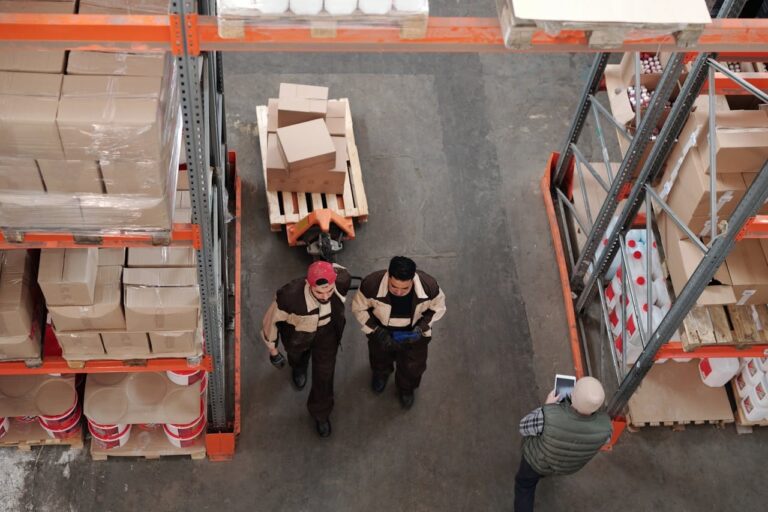Warehouses play a crucial role in the global supply chain, facilitating the smooth transition of goods from manufacturers to consumers. However, amid complex operations and heavy machinery, one crucial aspect often goes overlooked: pedestrian safety. Warehouses are busy environments with forklifts, trucks, and pallet jacks moving constantly, posing significant risks to workers on foot. Ensuring their safety is paramount but frequently neglected. Pedestrian safety often takes a back seat to productivity, efficiency, and deadlines, resulting in inadequate training, poor visibility, and a lack of clearly defined walkways. This creates a hazardous environment where pedestrians and vehicles interact unpredictably, leading to potential collisions and injuries.
Prioritizing pedestrian safety is crucial for preventing accidents and fostering a secure working environment. Implementing comprehensive traffic management plans, enhancing training programs, and investing in technology can help mitigate these risks and ensure workers on foot are adequately protected while navigating the warehouse. For companies looking to secure financing options for implementing these safety measures, lamina.ca offers resources on loans, helping businesses invest in essential safety infrastructure.
Why Pedestrian Safety is Overlooked in Warehouses
Warehouses are bustling environments where the focus tends to be on productivity and efficiency. This often leads to pedestrian safety taking a back seat. Many warehouses prioritize the movement of goods and the operation of heavy machinery, underestimating the risks posed to pedestrians walking through these busy areas. With tight deadlines and high demand, management can overlook pedestrian safety protocols, emphasizing speed over comprehensive safety measures. This results in a lack of training, unclear pathways, and inadequate protective barriers. Incorporating Detroit security guards trained in pedestrian safety protocols can significantly improve warehouse safety. These guards can enforce designated walking areas, ensure proper signage, and be vigilant for potential hazards.
Key Risks to Pedestrians in Warehouse Settings
- Interaction Between Vehicles and Pedestrians
One of the most significant risks in warehouses is the interaction between motorized vehicles and pedestrians. Forklifts, pallet jacks, and other heavy vehicles often share the same space with workers on foot, creating a high-risk environment for accidents. Without dedicated pathways, pedestrians may inadvertently walk into areas where vehicles operate, increasing the potential for collisions.
- Poor Visibility and Inadequate Signage
Many warehouses suffer from poor visibility, especially in corners and at the ends of aisles. This issue is compounded by inadequate signage, making it difficult for both drivers and pedestrians to be aware of each other’s presence. Narrow aisles and cluttered storage areas further limit the line of sight, creating blind spots that can lead to accidental collisions.
- Lack of Defined Walkways
In many facilities, the absence of clearly defined and protected walkways leads to pedestrians and vehicles moving unpredictably. This increases the likelihood of collisions and injuries. Without dedicated pedestrian lanes marked clearly on the floor or protected by barriers, workers on foot may unintentionally cross paths with moving vehicles.
Strategies to Enhance Pedestrian Safety
- Implementing Strict Traffic Management Plans
A well-defined traffic management plan can significantly reduce the risk of accidents. This includes designated pedestrian walkways, clear signage, and specific traffic rules within the warehouse. Such plans should also establish speed limits for vehicles and introduce barriers to separate pedestrian areas from zones where vehicles operate.
- Training and Awareness Programs
Regular training sessions and awareness programs can educate both drivers and pedestrians about the potential hazards and the importance of following safety protocols. Tailored training should highlight safe walking routes, best practices for interacting with vehicles, and emergency procedures in case of accidents. Unfortunately, even with these precautions, accidents can still happen. If you’ve been injured in a pedestrian accident, a Peterborough injury lawyer can help you navigate the legal process
- Use of Technology
Technological solutions like wearable safety devices, which alert pedestrians and drivers to each other’s proximity, can be an effective way to prevent accidents. Advanced systems using RFID, ultrasonic sensors, and even AI-based camera systems can create a virtual safety net, providing alerts and automatic braking when collisions are imminent. Additionally, for increased security in your business, consider investing in alarm installation in Scarborough.
While warehouses continue to focus on various safety and security measures, pedestrian safety often remains an overlooked aspect. By recognizing the inherent risks and implementing effective strategies to mitigate these dangers, warehouses can ensure a safer environment for all employees. Prioritizing pedestrian safety not only protects workers but also enhances overall operational efficiency.


